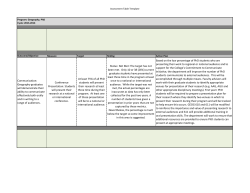
Master of Science in Medicine
MEDICINE The Stanford University Master of Science in Medicine Degree Program for PhD Students A Program to Teach Translational Medicine to Basic Scientists to Bridge the Gap between Basic Science and its Application to Human Disease Program Director: Ben A. Barres, MD, PhD barres@stanford.edu Program Administrator: Lorie Langdon lorie@stanford.edu msm.stanford.edu ____________________________________________________________________________________ Introduction and Overview The incredible pace of basic science discovery today stands in dramatic contrast to the slow rate of development of useful medical advances. There is an urgent need for a more efficient mechanism to generate a larger pool of scientists knowledgeable about human biology and disease. A recent National Research Council report called the training of PhD researchers to translate science to clinical medicine a “critical need.” The Master of Science in Medicine (MoM) degree program admits highly talented people who have a serious commitment to translational research but are not interested in becoming clinicians. Our goal is to train a new generation of PhD researchers who are highly knowledgeable about human biology and disease, and thus better equipped to translate new scientific discoveries into useful medical advances. Students matriculating into any of the PhD programs at Stanford University have the opportunity to apply for admission to this program on a competitive basis. Admitted students are jointly matriculated into their Stanford PhD program and the MoM Program, although they defer starting their PhD coursework until their second-year at Stanford. The MoM first-year program can be intense, particularly for students who may have had less previous exposure to biological sciences. During their first five quarters, successful applicants take basic biomedical science courses with the medical students including anatomy, physiology, genetics, immunology, and pathology. At the Stanford School of Medicine, our basic biomedical sciences curriculum is presented in a succinct format four days per week, allowing time for MoM students to concurrently begin their PhD lab rotations. In addition, to make more time for scholarly endeavor, every lecture is videotaped and available the day of the lecture for viewing. In their second year, MoM students will choose a lab for their thesis research, and also elect a clinical mentor with whom to discuss translational research needs and arrange a short clinical experience. Upon conclusion of their clinical experience, participating students will receive a Master of Science in Medicine Degree. With deferral of their first-year coursework, this program will extend the length of time for PhD completion by no more than one to one and one-half years. Stanford University School of Medicine has long been a world leader in medical training and research and is therefore an ideal location for this program. Under the leadership of School of Medicine Dean Emeritus Philip Pizzo, six new ‘Institutes of Medicine’ were launched. Their primary purpose is to promote translational research in the areas of Cancer, Stem Cell Biology and Regenerative Medicine, Cardiovascular Medicine, NeuroInnovation and Translational Neuroscience, Immunity, Transplantation and Infection, and Child Health. 2 The goal of the MoM program is to train basic scientists about human biology and disease. The MoM curriculum will provide students with a solid foundation of knowledge about the human body and disease processes, and teach them to translate basic research into useful medical advances. This foundation will provide the language to interact with clinicians and the ability to read and understand clinical journals. Students will learn what human diseases are, what is known – and not known – about their cause, diagnosis, pathophysiology, and treatment. The ability of basic researchers to interact in small teams with clinicians will be increasingly important in translation medicine. Graduates of the program will gain a valuable credential certifying they have received extensive training in human biology and disease. Admissions Admission into the MoM program will be on a competitive basis. Entering PhD students who matriculate in any of the Schools of Stanford University will have the opportunity to apply. These include the School of Engineering (Departments of Bioengineering, Chemical, Electrical, and Mechanical Engineering and Computer Science), the School of Humanities and Sciences (Departments of Biology, Chemistry, and Physics), and the School of Medicine. The School of Medicine offers PhD programs in Biochemistry, Biomedical Informatics, Biophysics, Cancer Biology, Developmental Biology, Genetics, Immunology, Microbiology and Immunology, Molecular and Cellular Physiology, Chemical and Systems Biology, Neurosciences, Stem Cell Biology and Regenerative Medicine, and Structural Biology. All students matriculating into any of these PhD programs are eligible to apply to the MoM Program. We will contact these students after they have officially accepted admission into their PhD program (shortly after April 15), and let them know of their eligibility and the process for applying. The MoM application will include each student's Stanford PhD program application materials and one additional essay about why he or she is interested in the program. All applications will be reviewed by the MoM Steering Committee, which will select a group of finalists for phone interviews. Students accepted into the MoM program will be notified by early June. Tuition and Financial Considerations The full cost of PhD training (tuition, stipend, and health insurance) is covered by the home PhD program. Similarly, the MoM Program will provide financial support to cover the full tuition, stipend, and health insurance costs for up to six MoM students for their first MoM year. The number of students that can be supported will depend on the availability of funding. At the beginning of the second program year, the full support of each MoM student will be covered by the home PhD program. Tuition for the medical school courses (taken by MoM students in their second program year), is covered by the MOM Program and the School of Medicine. Further Information For more detailed information about the MoM program please visit, http://msm.stanford.edu. 2015 3
© Copyright 2025









